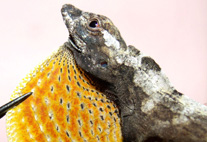Abstract
Steppe racerunner, Eremias (Eremias) arguta, is one of the most widespread species of the Asian racerunners (genus Eremias). Several subspecies were traditionally recognized however, morphological variability is so high that delimitation of these subspecies was always problematic. Here we present a phylogenetic hypothesis for this species based on cytochrome b sequences (55 samples from 35 populations, 900 bp partial sequences), infer it biogeography and the revise its subspecific structure. Six major phylogenetic lineages were revealed. The southernmost populations (E. a. uzbekistanica) from Uzbekistan form a clade together with the Issyk-Kul Lake subspecies (E. a. darevskii) based on both molecular and morphological evidence. Within more northern populations, there is a split between populations from Northern Caucasus, Europe and Western Kazakhstan (E. a. deserti) and Central and Eastern Kazakhstan populations (E. a. arguta). Transcaucasian (E. a. transcaucasica) steppe racerunners are grouped with Middle Asian populations. Finally, the easternmost samples, assigned to “E. a. potanini” are nested within the E. a. arguta clade. Populations from the Ili River Valley form a separate lineage sister to the clade joining all other E. arguta lineages and might represent a yet undescribed taxon. Species distribution in relation to historical biogeography of Middle Asia is discussed.

